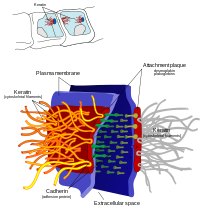Hereditary Mucoepithelial Dysplasia

Hereditary mucoepithelial dysplasia (HMD) is a very rare condition that affects the skin, hair, mucosa (areas of the body that are lined with mucus), gums (gingiva), eyes, nose and lungs. Symptoms begin in infancy and vary in severity from person to person. The most common symptoms of this condition include hair loss (alopecia), patchy red skin around the perineum (the area between the anus and external genitalia); and red gums. Small, skin-colored bumps (keratosis pilaris) and early development of cloudy lens (cataracts) are also common. Other symptoms may include eye disease that gets worse over time, lung disease and a rough, red tongue. Intelligence is normal.
The exact cause of HMD is still unknown, but it is thought to be an abnormality in desmosomes and gap junctions, which are cell structures involved in cell-to-cell contact. HMD appears to be inherited in an autosomal dominant pattern, but has occurred in individuals with no family history of the condition. The diagnosis of HMD is based on the symptoms and other skin and eye disorders need to be excluded. HMD is very rare and has been reported in less than 30 people in the literature. Treatment typically focuses on individual symptoms of the condition. The long-term outlook for people with HMD is unknown.
The exact cause of HMD is still unknown, but it is thought to be an abnormality in desmosomes and gap junctions, which are cell structures involved in cell-to-cell contact. HMD appears to be inherited in an autosomal dominant pattern, but has occurred in individuals with no family history of the condition. The diagnosis of HMD is based on the symptoms and other skin and eye disorders need to be excluded. HMD is very rare and has been reported in less than 30 people in the literature. Treatment typically focuses on individual symptoms of the condition. The long-term outlook for people with HMD is unknown.